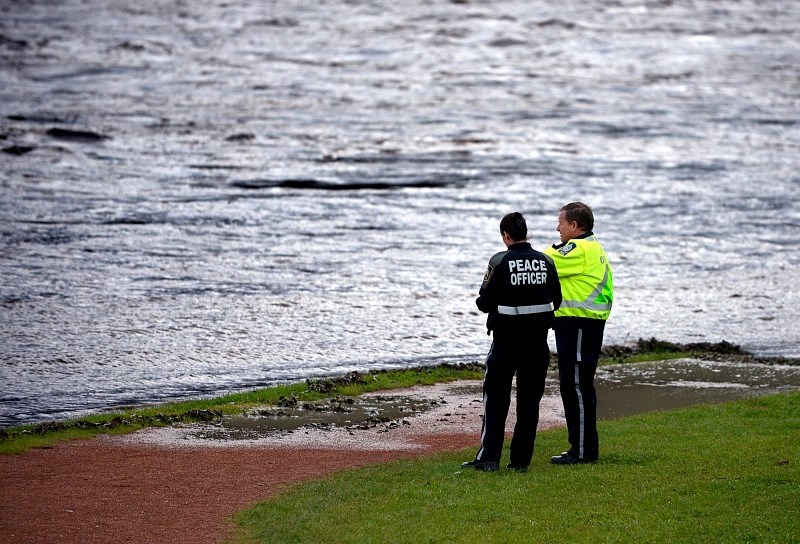COCHRANE— Changes to the Alberta Disaster Relief Program has the potential to leave municipalities facing a hefty bill when natural disasters strike.
Budget 2021 included a redesigned Disaster Relief Program with $2.5 billion in contingency funds for disasters and emergencies, but added an additional burden to municipalities with a requirement that they cover 10 per cent of disaster relief funds.
The changes take effect on April 1.
While he appreciates why the province felt the need to encourage municipalities, homeowners and developers to consider where projects are placed and how this can help prevent disasters, said Mayor Jeff Genung, he is worried about the long-term impacts of the changes to the Disaster Relief Program.
“We need to think about where we’re rebuilding— That’s the intent,” Genung said. “But, putting the 10 per cent on the municipality is a very difficult and dangerous path.”
Genung said he understands cautious budget reductions were necessary this year, especially given COVID-19 and the challenges the Alberta economy has faced, and how this adversity has necessitated changes to how funding is allocated in the province.
The Town of Cochrane is exploring the changes to Disaster Relief Program to better understand how the municipality will be impacted.
“This comes in a time we’re being asked to spend less and cut back. It’s a download onto municipalities again,” Genung said. “The impact to us long term is where we are really focussed— We need a little more time to contemplate and come up with a strategy with how we face a potential disaster cost."
Airdrie-Cochrane MLA Peter Guthrie said those who live in a flood plain or in an area that experiences flooding regularly will potentially be impacted by the changes to disaster relief funding— This includes areas of Cochrane.
In Cochrane, the 2013 flood resulted in more than $1.7 million in damages, while Rocky View County saw an estimated $2.39 million in damages and Calgary saw about $256 million in damages. Overall, the flood left an estimated $6 million repair bill in its wake for Alberta.
The changes to funding in Budget 2021 include placing a cap on a single property claiming $500,000 in relief funding to provide one-time assistance.
“If you’re building in an area that traditionally has the capacity to flood, taxpayers shouldn’t be on the hook for repeatedly ... Having to pay for disaster relief for those particular properties,” Guthrie said. “Putting the one-time limit on that does stop that.”
He added mitigation plans are being pursued by the province to help aid in preventing disasters like the 2013 flood. Guthrie cited the creation of the Springbank Off-Stream Reservoir as an example.
“We’re not going to ignore the fact that a flood risk exists, we don’t want it to happen and we are going to do our best to mitigate any future risks,” Guthrie said.
Alberta Urban Municipalities Association president Barry Morishita said the 90/10 split in disaster relief between the province and municipalities is a download of responsibility to local governments.
The change in funding allocation is another blow to municipalities facing a challenging financial future due to cuts in Municipal Sustainability Initiative funding.
The Municipal Sustainability Initiative is a key source of funding for municipalities and is facing an overall reduction of 25 per cent over the next three years.
The Initiative is set at $1.2 billion for 2021-22. The funding will be reduced to $485 million in 2022-23, $485 million in 2023-24 and $722 million in 2024-25.
“Now they’re going to ask municipalities to pay another 10 per cent for disaster relief, at the same time they don’t want us to increase taxes and they don’t want us to cut services,” Morishita said. “It puts municipalities in a very difficult situation.”
The cuts to Municipal Sustainability Initiative funding will also make it challenging to build reserves in preparation for potential disasters, he said, adding a further burden to municipalities.
It would be devastating for smaller municipalities in the province to be hit with a massive bill for disaster relief and many would struggle or be unable to fully cover the costs, he said.
Morishita noted Alberta experiences more natural disasters in comparison to other provinces, and municipalities contribute provincially to help areas when a disaster occurs. It makes sense for the provincial government to work with the federal government when these situations occur.
While mitigation projects are being established to help prevent or lessen the impact of disasters, these initiatives have been a long time coming and, in some cases, may not be enough to lessen the blow of natural disasters.
“That’s definitely the right road to go down, but at the end of the day telling municipalities they’re on the hook for 10 per cent … It would devastate them for years to come,” Morishita said.
While other provinces do have similar splits of disaster relief funding, the change should have been based on the needs of Alberta and worked to find a solution that benefits everyone.
“We don’t live in another province, we live in Alberta,” Morishita said. “We have more natural disasters than any other province by way of our geography and other circumstances— How do you put that into the equation, it’s just not fair.”




